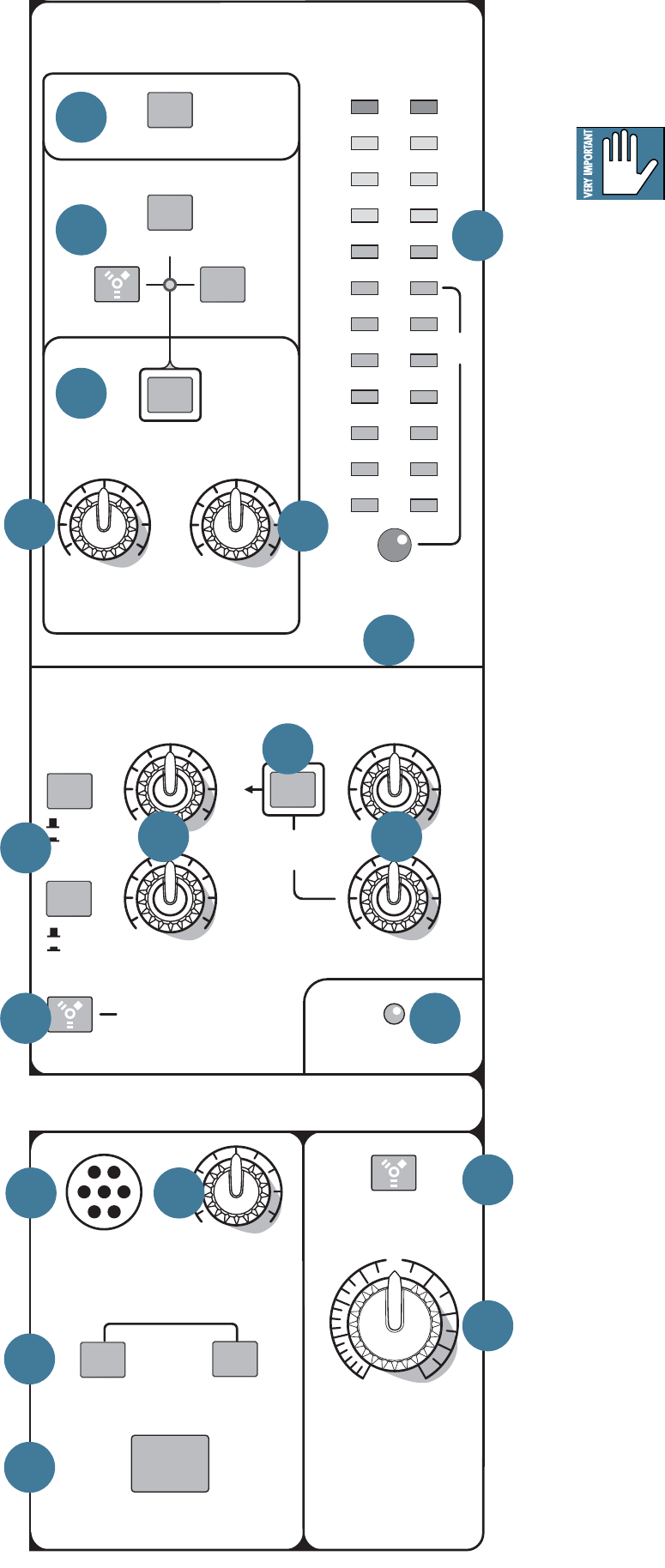
24 Onyx 820i
42. PHONES Knob
This controls the volume at the phones output, from
off to maximum gain.
WARNING: The headphone amp is loud, and
can cause permanent hearing damage. Even
intermediate levels may be painfully loud
with some headphones. BE CAREFUL! Always turn this
control all the way down before connecting headphones,
or pressing a solo switch [37], or doing anything new
that may affect the headphone volume. Then turn it up
slowly as you listen carefully.
43. LEFT/RIGHT Level Meters
These peak meters are made up of two columns of
twelve LEDs, with three colors to indicate different
ranges of signal level, traffi c light style. They range from
–30 at the bottom, to 0 in the middle, to +20 (CLIP) at
the top.
If no source [38, 39] is selected in the control room/
phones, and no channels are in solo, the meters won’t do
anything. To display signal levels, select one or more of
the sources. For example, press main mix [38] to show
the main mix level in the meters. While the listening
levels are controlled by the control room and phones
knobs, the meters indicate the source mix before these
knobs, giving you the real facts at all times, even if
you’re not listening at all.
When a channel is soloed, the left meter shows no
reading, and the right meter shows the level of that
channel’s signal level, pre-fader. The right meter's 0 dB
LED is labeled "level set" to show where the level should
be when adjusting a channel’s gain [23] in the solo
mode (as described in “Set the Levels” on page 3).
When 0 dBu (0.775 V) is at the main mix outputs, it
shows as 0 dB on the meters.
You can get a good mix with peaks fl ashing anywhere
between –20 and +10 dB on the meters. Most amplifi ers
clip at about +10 dBu, and some recorders aren’t so
forgiving either. For best real-world results, try to keep
your peaks between “0” and “+6.” Remember, audio
meters are just tools to help assure you that your levels
are “in the ballpark.” You don’t have to stare at them
(unless you want to).
44. RUDE SOLO Light
This large LED fl ashes when one or more channel solo
switches are engaged [37]. This acts as a reminder that
what you hear in the control room and headphones is
the soloed channel(s). If you forget you’re in solo mode,
you can easily be tricked into thinking that something
is wrong with your mixer. Hence, the rude solo light.
Please forgive its rudeness, it is only trying to help, and
wants to be your friend.
TAPE
AUX MASTER
2
1
SEND RETURN
2
1
MAIN MIX
CTRL ROOM/PHONES
SOURCE
PHONES
CONTROL
ROOM
RUDE
SOLO
20
15
10
6
3
0
2
4
7
10
20
30
LR
0dB=0dBu
LEVEL
SET
CLIP
MIC
PRE
POST
PRE
POST
+10dB
OO
U
RTN TO
AUX1
AUX SEND 1-2
TO FW 5-6
ASSIGN TO
FW 7-8
MAIN MIX
AUX 1-2
PHONES
DESTINATION
LEVEL
OO
MAX
TALKBACK
POWER
ALT 3
-
4
FW 1-2
ASSIGN TO
MAIN MIX
MAX
OO
MAX
OO
+15
OO
+15
OO
+10
OO
+10
OO
38
39
40
41
43
42
45
44
47
48
46
49 50
51 52
53
54
55
56


















